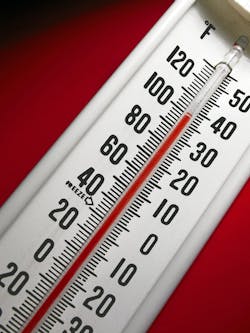Sometimes when a dry transformer fails, the cause is identified as heat. So the unit is replaced with one that has a lower temperature rise and thus a higher tolerance for the occasional overload that generates excess heat.
It’s typically not the heat per se that kills a transformer, but the degradation of the insulation from heat that does it. The winding insulation in a transformer with a lower temperature rise is going to experience less thermal stress and damage than the winding insulation in a standard transformer.
So what is transformer temperature rise? It’s the average rise in the temperature in the windings above the ambient temperature of a transformer loaded to its nameplate rating.
What’s the fundamental difference between two similar transformers when one has a lower temperature rise than the other? The one with the lower temperature rise is made better and is more efficient. That efficiency is typically a result (in large part) of using lower-resistance windings.
And because it’s more efficient, it uses less energy and generates less waste heat. The annual savings in energy costs may be in the thousands of dollars for larger transformers. Over the life of the more efficient unit, you will not just easily recoup the purchase premium—the energy savings from that transformer will pay for the entire purchase cost times over.
Not only that, a more efficient transformer is likely to last much longer because its insulation is subjected to less heat. This doesn’t mean you should ignore the recommended replacement interval (e.g., 25 years). It means better reliability between those recommended replacement times is part of what you are purchasing with the higher cost of a more efficient transformer.
Because less heat is being generated by the transformer, you also may save money on active ventilation to remove the heat. Or if the transformer is in an air-conditioned space, you’ll reduce the load on the air-conditioning system.
If you’re going to specify a transformer, ask the manufacturer for help in calculating the annual energy savings. They may even have an app for that.
Then consider something else that can affect your facility’s electrical bill. If you upgrade enough of your transformer capacity from a 150°C rise to an 80°C rise, that could bring you under the threshold for the electric utility’s peak load charge.
For example, the initial design with standard transformers will result in a peak load charge. But if you specify that every transformer will have an 80°C rise, you find that you’re below the peak load threshold (in your particular situation).
Or maybe you are not quite there, but very much closer. This means the charge will be considerably less than otherwise. Perhaps you can even negotiate that difference away with the utility. Or get below the threshold using other energy savings on top of this.
If you’re looking to replace a transformer, have a qualified thermographer perform a thermographic analysis on the existing installation (or if it can’t run, a similar one) and use those images to show the waste.
After a more efficient transformer is installed, have a new thermographic analysis done to show the improvement. You can use the before and after images as part of a report that justifies upgrading other existing transformers.
About the Author

Mark Lamendola
Mark is an expert in maintenance management, having racked up an impressive track record during his time working in the field. He also has extensive knowledge of, and practical expertise with, the National Electrical Code (NEC). Through his consulting business, he provides articles and training materials on electrical topics, specializing in making difficult subjects easy to understand and focusing on the practical aspects of electrical work.
Prior to starting his own business, Mark served as the Technical Editor on EC&M for six years, worked three years in nuclear maintenance, six years as a contract project engineer/project manager, three years as a systems engineer, and three years in plant maintenance management.
Mark earned an AAS degree from Rock Valley College, a BSEET from Columbia Pacific University, and an MBA from Lake Erie College. He’s also completed several related certifications over the years and even was formerly licensed as a Master Electrician. He is a Senior Member of the IEEE and past Chairman of the Kansas City Chapters of both the IEEE and the IEEE Computer Society. Mark also served as the program director for, a board member of, and webmaster of, the Midwest Chapter of the 7x24 Exchange. He has also held memberships with the following organizations: NETA, NFPA, International Association of Webmasters, and Institute of Certified Professional Managers.
